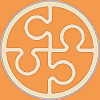His crowd business about 'Wisdom of numbers' only works for an established object. If it is guess the weight of the bull then you need a bull, and you'll get many informed farmers guessing around the weight of the bull and then increasingly ignorant people either side. Do a distribution curve of guesses and the mean probably will end up at the weight of the bull. It does not work for predicting something random like lottery numbers. So that was a lot of bull-shit.
In the end he controlled the trick to 'predict' all the numbers, not the crowd of his followers, with whom he led a merry dance to the end (by the end they'd lost their critical faculties). My own guess relates to the regular/ irregular jarring of the camera. Had it been dead still, the join would have been more obvious between the stored balls on our left and the lottery live on the right. Had a person held the camera, it would have swayed unpredictably, and it didn't. Channel 4 showed the programme twice and twice more on Channel 4 plus 1. I bumped into that bit three times! So a jarring camera can connect with a split screen perfectly with "today's technology" (and he did say "my" and "a trick").
His three ways of doing it were thus none of them. He didn't predict the numbers, fake the ticket or intervene with the machine. He did a trick. Of course had he/ they predicted the numbers, he would have simply put the numbers out in front of the people in the same room and watched the lottery show. But he didn't. He moved into a "TV studio" out of their way and ours, and there the trick was done. The numbers were put in with the lottery programme and the split screen was ended.
But I was more interested in the three coins together trick, that is not a trick. Of course getting the first chap to choose


 Heads Heads Heads did mean Darren Brown's second player had more chance to win (becomes more quickly). But my head is very mathematically thick. I did learn the chi squared method for a lesson connected to an interview (no news after a week!) but I was actually more interested in the bell curve. There is a bell curve in the coins game too - there has to be. So I looked at various solutions, including this mathematical one that got me nowhere, and then I realised the clue was in another non-transitive game called Rock, Scissors and Paper. It is about blocking and power.
Heads Heads Heads did mean Darren Brown's second player had more chance to win (becomes more quickly). But my head is very mathematically thick. I did learn the chi squared method for a lesson connected to an interview (no news after a week!) but I was actually more interested in the bell curve. There is a bell curve in the coins game too - there has to be. So I looked at various solutions, including this mathematical one that got me nowhere, and then I realised the clue was in another non-transitive game called Rock, Scissors and Paper. It is about blocking and power.Then I worked it out that packaged and maintained unevenness (into three, and a rule) triumphs over the impression of evenness (the coins). I drew a diagram (I used to understand diagrams when I did economics - I never understood the equations)
 that showed four combinations of three coin throws had cul-de-sacs and four combinations had two 'blocking' moves. Indeed, to take a combination, and copy the middle coin, reverse it, put it to the front, and take the first three, never produces the four combinations of three in the cul-de-sacs (this amounts to the same thing). So the rule is decisive, and can come from any of the eight combinations of three coins, but only four can be produced. Indeed these productions are the opposites of the blocking (thus amounting to the same thing - they are the physical expression of the rule).
that showed four combinations of three coin throws had cul-de-sacs and four combinations had two 'blocking' moves. Indeed, to take a combination, and copy the middle coin, reverse it, put it to the front, and take the first three, never produces the four combinations of three in the cul-de-sacs (this amounts to the same thing). So the rule is decisive, and can come from any of the eight combinations of three coins, but only four can be produced. Indeed these productions are the opposites of the blocking (thus amounting to the same thing - they are the physical expression of the rule).So I think logically, verbally and visually, and this was the result, added to my website. Some mathematician will tell me that I have the verbals somewhat wrong. Maybe I have (for example, the word 'block') but I think the explanation stands up and it would constitute that instruction "show your working" (not 'show you're working', which leads to a little cartoon).



No comments:
Post a Comment